Variation in the Floral Scent Chemistry of Nymphaea ‘Eldorado’, a Valuable Water Lily, with Different Flowering Stages and Flower Parts
Abstract
1. Introduction
2. Results
2.1. Volatile Compounds of the Flower Petals of N. ‘Eldorado’ at Different Development Stages
2.1.1. Chemical Constituents and Contents of Volatile Compounds at Different Flowering Stages of N. ‘Eldorado’
2.1.2. Comparison of the Main Volatile Compounds at Different Flowering Stages in N. ‘Eldorado’
2.1.3. Hierarchical Cluster Analysis and Principal Component Analysis of the Volatile Compounds
2.2. Volatile Components in Different Parts of N. ‘Eldorado’ Flowers
2.3. Differences in the Cell Structures of the Petals at Different Flowering Stages in N. ‘Eldorado’
3. Discussion
3.1. Differences in Floral Components of N. ‘Eldorado’ at Different Flowering Stages
3.2. Differences in Petal Structure at Different Flowering Stages and Their Relationships with Floral Release
3.3. Differences in Volatile Components in Different Parts of N. ‘Eldorado’ Flowers
4. Materials and Methods
4.1. Plant Materials
4.2. Microstructure of Petals with SEM and TEM
4.3. Analysis of Volatile Components
4.4. Statistical Analysis
5. Conclusions
Supplementary Materials
Author Contributions
Funding
Data Availability Statement
Acknowledgments
Conflicts of Interest
References
- Dudareva, N.; Klempien, A.; Muhlemann, J.K.; Kaplan, I. Biosynthesis, function and metabolic engineering of plant volatile organic compounds. New Phytol. 2013, 198, 16–32. [Google Scholar] [CrossRef]
- Abbas, F.; Yu, Y.; Bendahmane, M.; Huicong, W. Plant volatiles and color compounds: From biosynthesis to function. Physiol. Plant. 2023, 175, e13947. [Google Scholar] [CrossRef]
- Vega, C.D.; Herrera, C.M.; Tterl, S.D. Floral volatiles play a key role in specialized ant pollination. Perspect. Plant Ecol. 2014, 16, 32–42. [Google Scholar] [CrossRef]
- Junker, R.R. Floral scents repel facultative flower visitors, but attract obligate ones. Ann. Bot. 2010, 105, 777–782. [Google Scholar] [CrossRef] [PubMed]
- Pale-Ezquivel, I.; Aguirre-Jaimes, A.; Hernández, J.; Coates, R.; Domínguez, Z. Floral scents in Pachira aquatica (Malvaceae): A species with diverse floral visitors in a Mexican lowland forests. Nat. Prod. Commun. 2018, 13, 584–587. [Google Scholar] [CrossRef]
- Khan, M.; Khan, M.; Alshareef, E.; Alaqeel, S.I.; Alkhathlan, H.Z. Chemical characterization and chemotaxonomic significance of essential oil constituents of Matricaria aurea grown in two different Agro-Climatic conditions. Plants 2023, 12, 3553. [Google Scholar] [CrossRef] [PubMed]
- Chiu, Y.T.; Chen, H.C.; Chang, C. The variation of Oncidium Rosy Sunset flower volatiles with daily rhythm, flowering period, and flower parts. Molecules 2017, 22, 1468. [Google Scholar] [CrossRef] [PubMed]
- Fincheira, P.; Quiroz, A.; Tortella, G.; Diez, M.C.; Rubilar, O. Current advances in plant-microbe communication via volatile organic compounds as an innovative strategy to improve plant growth. Microbiol. Res. 2021, 247, 126726. [Google Scholar] [CrossRef] [PubMed]
- Llorens, L.; Tomàs, J.; Ferriol, P.; García, M.T.; Gil, L. Floral aroma and pollinator relationships in two sympatric late-summer-flowering Mediterranean Asparagus species. Plants 2023, 12, 3219. [Google Scholar] [CrossRef]
- Knudsen, J.T.; Eriksson, R.; Gershenzon, J.; Ståhl, B. Diversity and distribution of floral scent. Bot. Rev. 2006, 72, 1. [Google Scholar] [CrossRef]
- Fan, X.Y.H. Composition analysis of floral scent within genus Camellia uncovers substantial interspecific variations. Sci. Hortic. 2019, 250, 207–213. [Google Scholar] [CrossRef]
- Feng, L.G.; Chen, C.; Sheng, L.X.; Liu, P.; Tao, J.; Su, J.L.; Zhao, L.Y. Comparative analysis of headspace volatiles of Chinese Rosa rugosa. Molecules 2010, 15, 8390–8399. [Google Scholar] [CrossRef] [PubMed]
- Yuan, Z.Y.; Qu, H.Y.; Xie, M.Z.; Zeng, G.; Huang, H.Y.; Ren, F.; Naihong, C. Direct authentication of three Chinese materia medica species of the Lilii Bulbus family in terms of volatile components by headspace-gas chromatography-ion mobility spectrometry. Anal. Methods 2019, 11, 530–536. [Google Scholar] [CrossRef]
- Robustelli della Cuna, F.S.; Calevo, J.; Bazzicalupo, M.; Sottani, C.; Grignani, E.; Preda, S. Chemical composition of essential oil from flowers of five fragrant Dendrobium (Orchidaceae). Plants 2021, 10, 1718. [Google Scholar] [CrossRef] [PubMed]
- Liu, G.; Yang, M.; Fu, J. Identification and characterization of two sesquiterpene synthase genes involved in volatile-mediated defense in tea plant (Camellia sinensis). Plant Physiol. Biochem. 2020, 155, 650–657. [Google Scholar] [CrossRef] [PubMed]
- Zhao, K.; Yang, W.; Zhou, Y.; Zhang, J.; Li, Y.; Sagheer, A.; Zhang, Q.X. Comparative transcriptome reveals benzenoid biosynthesis regulation as inducer of floral scent in the woody plant Prunus mume. Front. Plant Sci. 2017, 8, 319. [Google Scholar] [CrossRef]
- Zhang, H.; Leng, P.; Hu, Z.; Zhao, J.; Wang, W.; Xu, F. The floral scent emitted from ‘Siberia’ at different flowering stages and diurnal variation. Acta Hortic. Sin. 2013, 40, 693–702. [Google Scholar] [CrossRef]
- Zhang, Y.; Li, W.; Lu, Y. Characterization of emitted volatiles and key genes in Lilium longiflorum × asiatic. Acta Hortic. Sin. 2018, 45, 702–716. [Google Scholar] [CrossRef]
- Yu, Y.; Lyu, S.; Chen, D.; Lin, Y.; Chen, J.; Chen, G.; Ye, N. Volatiles emitted at different flowering stages of Jasminum sambac and expression of genes related to α-Farnesene biosynthesis. Molecules 2017, 22, 546. [Google Scholar] [CrossRef]
- Mus, A.A.; Azlan, G.J.; Kumar, V.S.; Rusdi, N.A. The variation of volatile compounds emitted from aromatic orchid (Phalaenopsis bellina) at different timing and flowering stages. Plant Omics 2020, 13, 78–85. [Google Scholar] [CrossRef]
- Yu, R.; Li, Y.; Si, D.; Yan, S.; Liu, J.; Si, J.; Zhang, X. Identification, quantitative and bioactivity analyses of aroma and alcohol-soluble components in flowers of Gardenia jasminoides and its variety during different drying processes. Food Chem. 2023, 420, 135846. [Google Scholar] [CrossRef]
- Xu, H.; Yao, X.; Tong, K.; Xing, Z.; Li, Y. Analysis of volatile components in different parts of flower organs of three species of tree peony. Nanjing For. Univ. 2023, 47, 63–69. [Google Scholar] [CrossRef]
- Xu, L.; Yu, F. Corolla structure and fragrance components in Styrax tonkinensis. Trees 2015, 29, 1127–1134. [Google Scholar] [CrossRef]
- Guo, Y.; Zhang, T.; Zhong, J.; Ba, T.; Xu, T.; Zhang, Q.; Sun, M. Identification of the volatile compounds and observation of the glandular trichomes in Opisthopappus taihangensis and four species of Chrysanthemum. Plants 2020, 9, 855. [Google Scholar] [CrossRef] [PubMed]
- Zhang, H.H.; Wu, H.Y.; Zhou, Q.; Zhao, R.N.; Zhu, Z.L. Flowering characteristics and reproductive biology of Nymphaea hybrid, a precious water lily. Sci. Hortic. 2021, 287, 110268. [Google Scholar] [CrossRef]
- Povilus, R.A.; Losada, J.M.; Friedman, W.E. Floral biology and ovule and seed ontogeny of Nymphaea thermarum, water lily at the brink of extinction with potential as a model system for basal angiosperms. Ann. Bot. 2015, 115, 211–226. [Google Scholar] [CrossRef]
- Zhou, Q.; Zeng, Y.; Zhu, Z.L. Extraction optimization through response surface methodology and antioxidant activity of polyphenols of Nymphaea Hybrid. Mod. Food Sci. Technol. 2018, 34, 200–207. [Google Scholar] [CrossRef]
- Yin, D.D.; Yuan, R.Y.; Wu, Q.; Li, S.S.; Shao, S.; Xu, Y.J.; Hao, X.H.; Wang, L.S. Assessment of flavonoids and volatile compounds in tea infusions of water lily flowers and their antioxidant activities. Food Chem. 2015, 187, 20–28. [Google Scholar] [CrossRef]
- Tsai, F.J.; Liu, H.J.; Lee, M.Y.; Lin, C.C. Determination of volatile components from live water lily flowers by an orthogonal-array-design-assisted trapping cell. Appl. Sci. 2019, 9, 1269. [Google Scholar] [CrossRef]
- Maia, A.C.D.; De Lima, C.T.; Navarro, D.M.D.A.F.; Chartier, M.; Giulietti, A.M.; Machado, I.C. The floral scents of Nymphaea subg. Hydrocallis (Nymphaeaceae), the new world night-blooming water lilies, and their relation with putative pollinators. Phytochemistry 2014, 103, 67–75. [Google Scholar] [CrossRef]
- Zhang, L.; Chen, F.; Zhang, X.; Li, Z.; Zhao, Y.; Lohaus, R.; Chang, X.; Dong, W.; Ho, S.Y.W.; Liu, X.; et al. The water lily genome and the early evolution of flowering plants. Nature 2020, 577, 79–84. [Google Scholar] [CrossRef]
- Sun, Q.; Tian, M.; Wang, H.; Wang, L.; Liu, J.; Zhao, P.; Bu, Z. Volatile components in flowers of 62 Nymphaea cultivars by GC-MS. J. Trop. Subtrop. Bot. 2022, 30, 567–574. [Google Scholar] [CrossRef]
- Zhou, Q.; Shi, M.; Zhang, H.; Zhu, Z. Comparative study of the petal structure and fragrance components of the Nymphaea hybrid, a precious water lily. Molecules 2022, 27, 408. [Google Scholar] [CrossRef] [PubMed]
- Yang, Z.; Yan, H.; Liao, W.; Bai, D.; Li, H. Analysis on chemical components in flower tea of different varieties of Nymphaea teeagona. J. Anhui Agric. Sci. 2019, 47, 214–215. [Google Scholar] [CrossRef]
- Su, Q.; Bu, C.; Zhang, J.; Tian, M.; Mao, L.; Lu, J.; Zhao, P.; Huang, C. Research progress and prospect on waterlily. Jiangsu Agric. Sci. 2019, 47, 79–83. [Google Scholar] [CrossRef]
- Zhao, J.; Xu, F.; Ji, T.; Gu, Z.; Li, C. Advances in the study on chemical constituents and biological activities in Nymphaea Genus. Nat. Prod. Res. Dev. 2014, 26, 142–147. [Google Scholar] [CrossRef]
- Chen, Y.; Fan, Y.; Li, Z.; Li, Z.; Wang, J.; Zhao, Y.; Luo, H. Extraction of essential oil from tropical water lily and its antibacterial activities. Food Res. Dev. 2022, 43, 32–38. [Google Scholar] [CrossRef]
- Azam, M.; Song, M.; Fan, F.; Zhang, B.; Xu, Y.; Xu, C.; Chen, K. Comparative analysis of flower volatiles from nine citrus at three blooming stages. Int. J. Mol. Sci. 2013, 14, 22346–22367. [Google Scholar] [CrossRef]
- Qin, X.W.; Hao, C.Y.; He, S.Z.; Wu, G.; Tan, L.H.; Xu, F.; Hu, R.S. Volatile Organic Compound Emissions from Different Stages of Cananga odorata Flower Development. Molecules 2014, 19, 8965–8980. [Google Scholar] [CrossRef]
- Al-Kateb, H.; Mottram, D.S. The relationship between growth stages and aroma composition of lemon basil Ocimum citriodorum Vis. Food Chem. 2014, 152, 440–446. [Google Scholar] [CrossRef]
- Li, Y.; Wan, Y.; Sun, Z.; Li, T.; Liu, X.; Ma, H.; Liu, X.; He, R.; Ma, Y.; Li, Z. Floral scent chemistry of Luculia yunnanensis (Rubiaceae), a species endemic to China with sweetly fragrant flowers. Molecules 2017, 22, 879. [Google Scholar] [CrossRef]
- Yuan, R.; Li, S.; Zheng, X.; Wu, Q.; Zhang, H.; Wang, L. Determination of volatiles in water lily flowers using gas chromatography-mass spectrometry. Anal. Lett. 2014, 47, 1541–1551. [Google Scholar] [CrossRef]
- Dosoky, N.S.; Shah, S.A.; Dawson, J.T.; Banjara, S.S.; Poudel, A.; Bascoul, C.; Satyal, P. Chemical composition, market survey, and safety assessment of blue lotus (Nymphaea caerulea Savigny) extracts. Molecules 2023, 28, 7014. [Google Scholar] [CrossRef] [PubMed]
- Rijpkema, A.; Gerats, T.; Vandenbussche, M. Genetics of floral development in Petunia. Adv. Bot. Res. 2006, 44, 237–278. [Google Scholar] [CrossRef]
- Meng, Y.; Li, N.; Tian, J.; Gao, J.; Zhang, C. Identification and validation of reference genes for gene expression studies in postharvest rose flower (Rosa hybrida). Sci. Hortic. 2013, 158, 16–21. [Google Scholar] [CrossRef]
- Wright, G.A.; Schiestl, F.P. The evolution of floral scent: The influence of olfactory learning by insect pollinators on the honest signalling of floral rewards. Funct. Ecol. 2010, 23, 841–851. [Google Scholar] [CrossRef]
- Melisa, Z.L.; Gloria, G.B.; Marina, G.; Gabriela, Z.; Silvia, F.M. Carpellary appendages in Nymphaea and Victoria (Nymphaeaceae): Evidence of their role as osmophores based on morphology, anatomy and ultrastructure. Bot. J. Linn. Soc. 2019, 191, 421–439. [Google Scholar] [CrossRef]
- Shi, T.; Yang, X.; Wang, L. Dynamic characteristics of floral components and anatomical observation of petals in three cultivars of Osmanthus fragrans. Nanjing For. Univ. 2020, 44, 12–20. [Google Scholar] [CrossRef]
- Zhang, L.X.; Shi, Z.P. Research on the cell microstructure of Jasminum sambac’s petal. J. Hunan Agric. Univ. 1999, 25, 108–111. [Google Scholar] [CrossRef]
- Wiemer, A.P.; Mor, M.; Benitez-Vieyra, S.; Cocucci, A.A.; Raguso, R.A.; Sérsic, A.N. A simple floral fragrance and unusual osmophore structure in Cyclopogon elatus (Orchidaceae). Plant Biol. 2010, 11, 506–514. [Google Scholar] [CrossRef]
- Rudall, P.J.; Bateman, R.M.; Eastman, F.A. Floral anatomy and systematics of Alliaceae with particular reference to Gilliesia, a presumed insect mimic with strongly zygomorphic flowers. Am. J. Bot. 2002, 89, 1867–1883. [Google Scholar] [CrossRef] [PubMed]
- Nell, A.M.B.A. Effects of ethylene on volatile emission and fragrance in cut roses: The relationship between fragrance and vase life. Postharvest Biol. Technol. 2011, 59, 245–252. [Google Scholar] [CrossRef]
- Huang, Q.; Mao, L.; Long, L.; Tang, Y. Optimization of essential oil from tropical water lily extracted by supercritical CO2 and volatile components of essential oil analysis by GC-MS. Food Res. Dev. 2020, 41, 188–195. [Google Scholar] [CrossRef]
- Tang, Y.W.; Li, J.H.; Mao, L.Y.; Long, L.Y.; Huang, Q.W.; Yu, Y.P.; Su, Q.; Wang, Y.H. Analysis of metabolites in different tissues of water lily flowers based on metabonomics. Southwest China J. Agric. Sci. 2022, 35, 1657–1664. [Google Scholar] [CrossRef]
- Ramya, M.; Jang, S.; An, H.R.; Lee, S.Y.; Park, P.M.; Park, P.H. Volatile organic compounds from Orchids: From synthesis and function to gene regulation. Int. J. Mol. Sci. 2020, 21, 1160. [Google Scholar] [CrossRef] [PubMed]
- Mao, L.; Tan, X.; Long, L.; Huang, Q.; Deng, Y.; Yu, Y.; Ding, L.; Wei, Y. Sequencing analysis of transcriptome in different parts of Nymphaea Paul Stetson flower. J. Plant Genet. Resour. 2023. [Google Scholar] [CrossRef]
- Marinho, C.R.; Souza, C.D.; Barros, T.C.; Teixeira, S.P. Scent glands in legume flowers. Plant Biol. 2014, 16, 215–226. [Google Scholar] [CrossRef]
- Russo, F.; Caporaso, N.; Paduano, A.; Sacchi, R. Characterisation of volatile compounds in Cilento (Italy) figs (Ficus carica L.) cv. Dottato as affected by the drying process. Int. J. Food Prop. 2017, 20, 1366–1376. [Google Scholar] [CrossRef][Green Version]
- NIST Chemistry WebBook. Available online: https://webbook.nist.gov/chemistry/ (accessed on 22 September 2023).
- PubChem. Available online: https://pubchem.ncbi.nlm.nih.gov/ (accessed on 22 September 2023).
- The Pherobase: Database of Pheromones and Semiochemicals. Available online: https://www.pherobase.com (accessed on 25 September 2023).
- Lukić, I.; Išić, N.; Ban, D.; Salopek Sondi, B.; Goreta Ban, S. Comprehensive volatilome signature of various Brassicaceae species. Plants 2023, 12, 177. [Google Scholar] [CrossRef]
- Zidi, K.; Kati, D.E.; Bachir-Bey, M.; Genva, M.; Fauconnier, M.L. Comparative study of fig volatile compounds using headspace solid-phase microextraction-gas chromatography/mass spectrometry: Effects of cultivars and ripening stages. Front. Plant Sci. 2021, 12, 667809. [Google Scholar] [CrossRef]
- Xu, H.; Zhang, W.M.; Jiang, H.F.; Jin, J.H.; Shan, C.Y.; Zhang, J. Analysis of essential oil from the flowers of Nymphaea hybrida by GC-MS. Food Res. Dev. 2008, 29, 101–103. [Google Scholar] [CrossRef]
- Shi, N.; Liu, X.J.; Du, F.F.; Chang, Y.J.; Li, N.W.; Yao, D.R. GC-MS analysis on components of essential oil from fresh flowers of tropical water lily. J. Plant Res. Environ. 2017, 26, 104–106. [Google Scholar] [CrossRef]
- Li, T.; Zhao, X.; Cao, X. Volatile metabolome and aroma differences of six cultivars of Prunus mume blossoms. Plants 2023, 12, 308. [Google Scholar] [CrossRef] [PubMed]


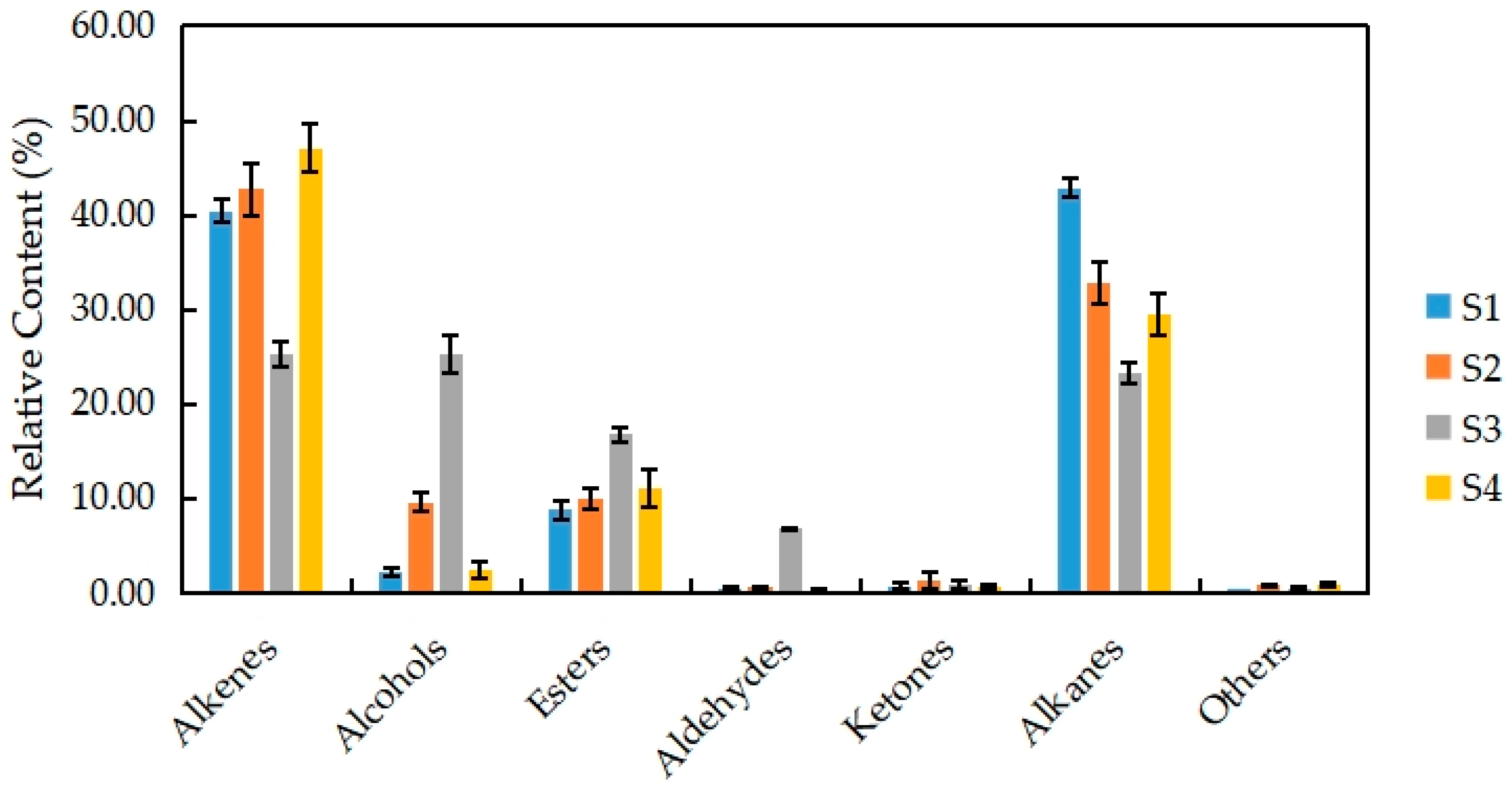
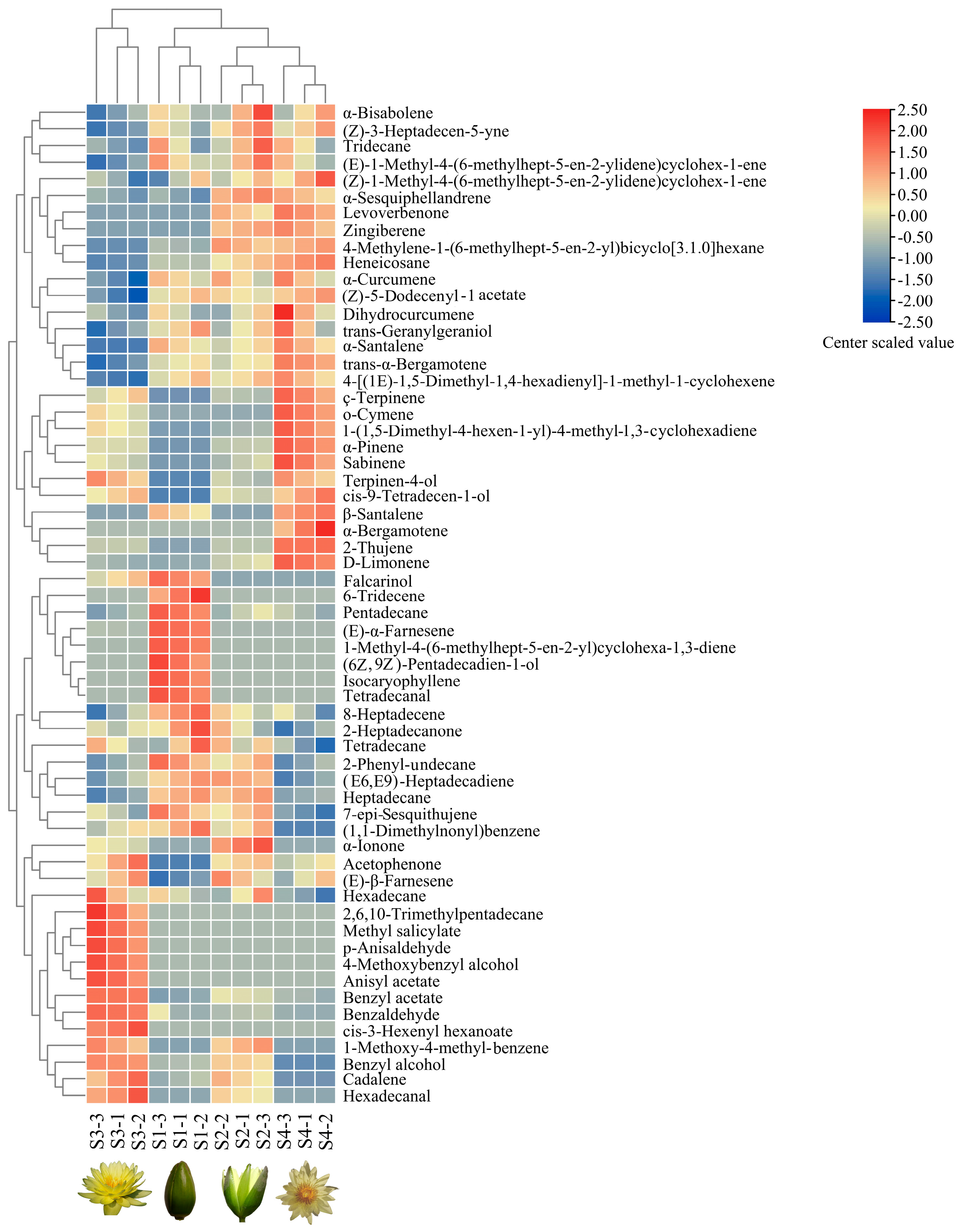
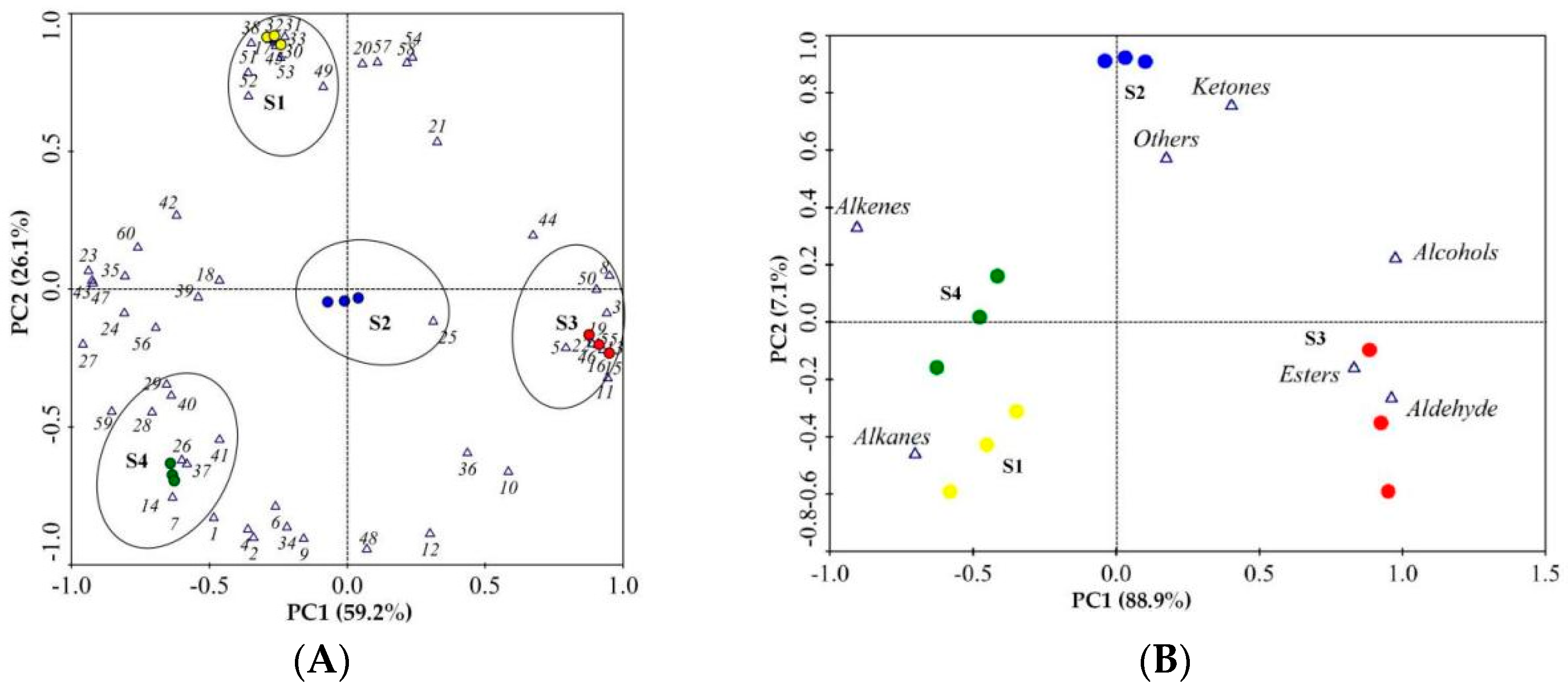
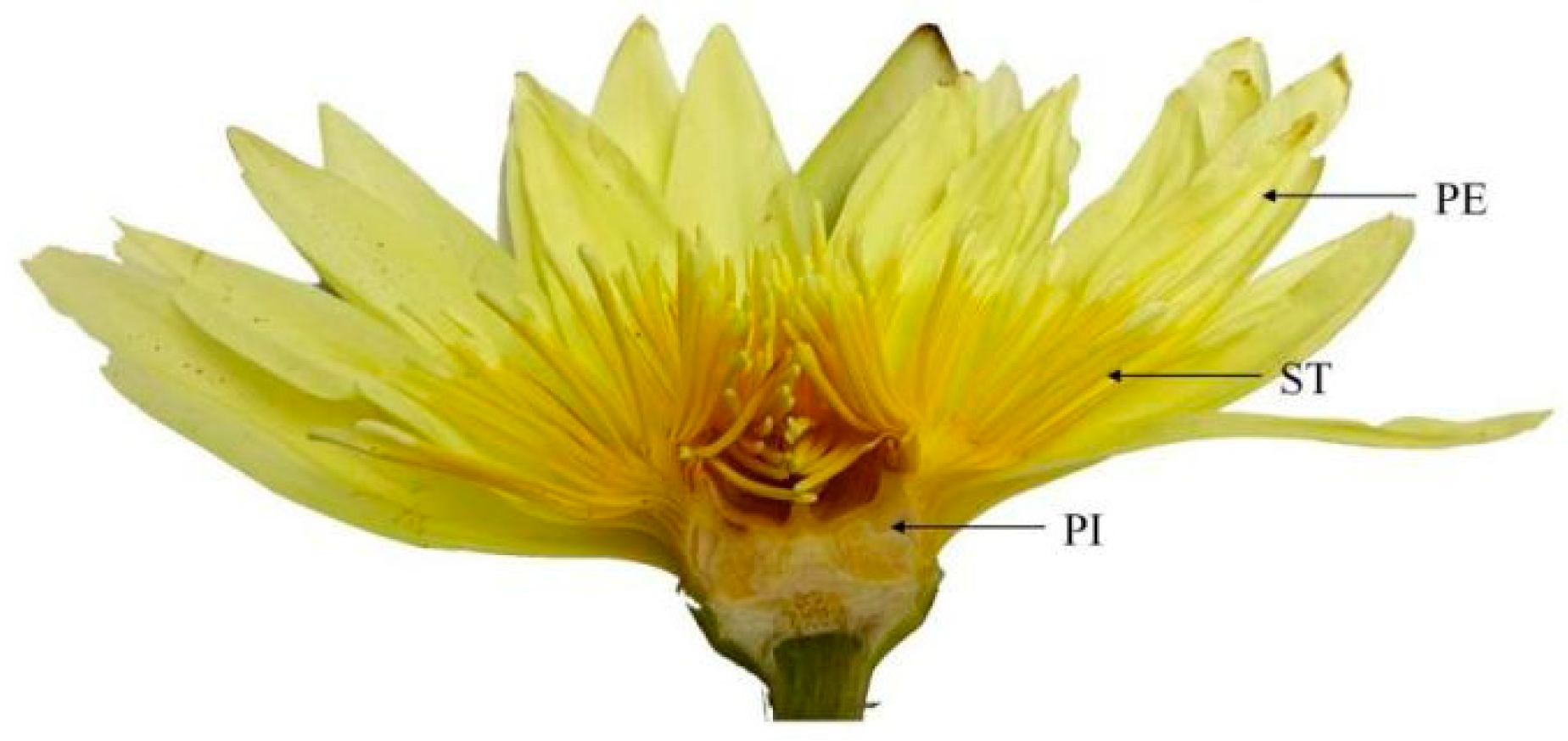

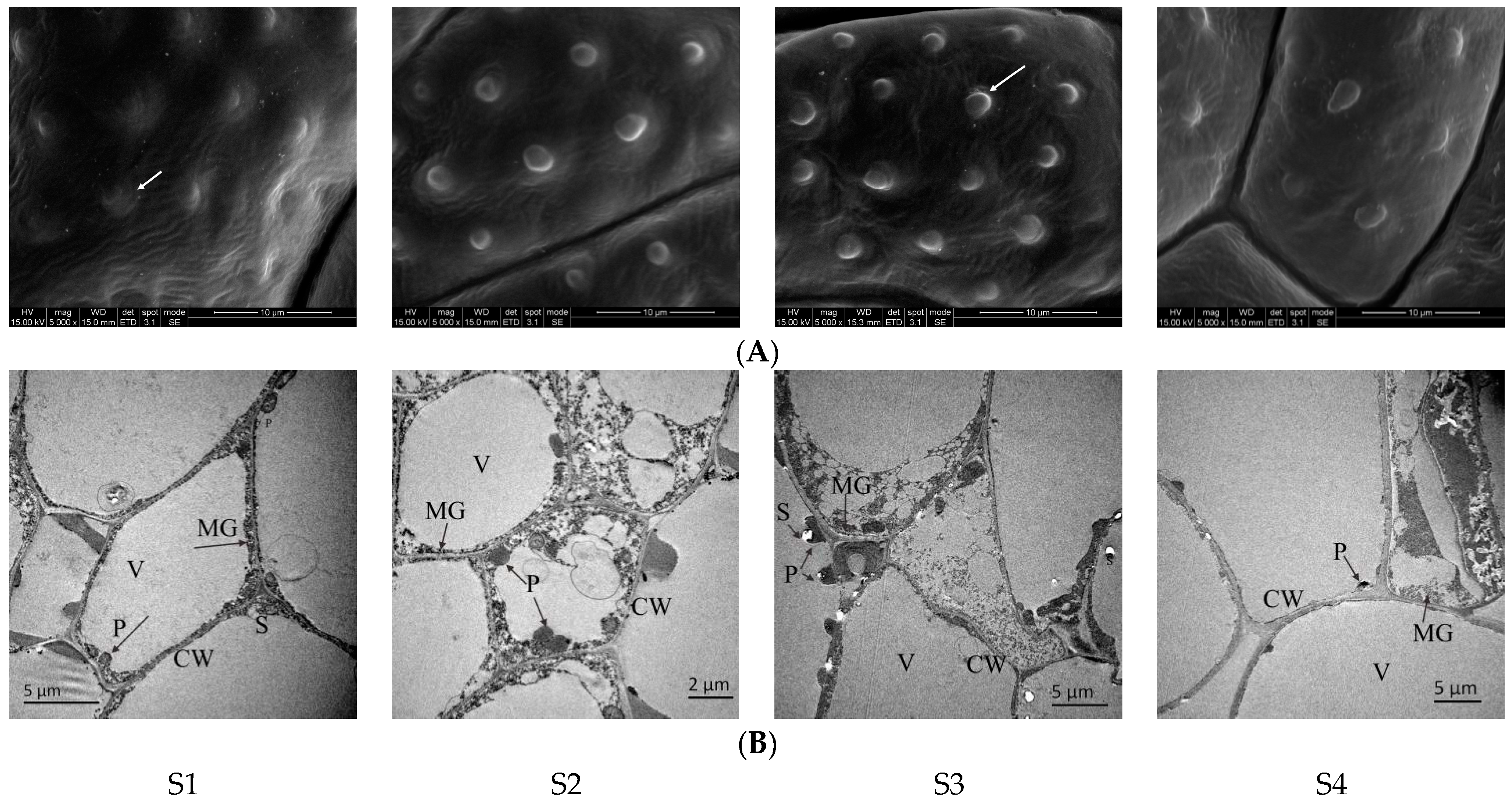
| NO. | RI (exp.) | RI (lit.) | Compounds | Molecular Formula | Aroma Description 1 | Relative Content (%) 2 | |||
|---|---|---|---|---|---|---|---|---|---|
| S1 | S2 | S3 | S4 | ||||||
| 1 | 938 | 930 | 2-Thujene | C10H16 | Woody, green, herbal | - | 0.07 b | 0.08 b | 0.38 a |
| 2 | 940 | 946 | α-Pinene | C10H16 | Pine, turpentine | - | 0.17 c | 0.23 b | 0.71 a |
| 3 | 958 | 963 | Benzaldehyde | C7H6O | Cherry, fruity | 0.14 c | 0.38 b | 5.78 a | 0.08 |
| 4 | 975 | 977 | Sabinene | C10H16 | Pepper, turpentine, woody | - | 0.19 c | 0.25 b | 0.87 a |
| 5 | 1002 | 1005 | 1-Methoxy-4-methyl-benzene | C8H10O | Nutty | - | 0.14 a | 0.15 a | - |
| 6 | 1030 | 1022 | o-Cymene | C10H14 | Solvent, gasoline, citrus | - | - | 0.12 b | 0.31 a |
| 7 | 1032 | 1198 | D-Limonene | C10H16 | Citrus, mint | 0.20 d | 0.60 b | 0.28 c | 2.44 a |
| 8 | 1035 | 1037 | Benzyl alcohol | C7H8O | Sweet, flower | 1.80 c | 8.69 b | 23.43 a | 0.12 d |
| 9 | 1052 | 1058 | ç-Terpinene | C10H16 | Lemon | - | 0.21 c | 0.45 b | 0.97 a |
| 10 | 1065 | 1067 | Acetophenone | C8H8O | Must, flower, almond | - | 0.30 b | 0.39 a | 0.20 c |
| 11 | 1170 | 1166 | Benzyl acetate | C9H10O2 | Fresh, boiled vegetable | 0.42 d | 2.12 b | 12.15 a | 0.86 c |
| 12 | 1162 | 1164 | Terpinen-4-ol | C10H18O | Turpentine, nutmeg | - | 0.10 b | 0.26 a | 0.25 a |
| 13 | 1188 | 1193 | Methyl salicylate | C8H8O3 | Peppermint | - | - | 0.09 a | - |
| 14 | 1215 | 1220 | Levoverbenone | C10H14O | Camphor, menthol | - | 0.09 b | - | 0.13 a |
| 15 | 1245 | 1252 | p-Anisaldehyde | C8H8O2 | Mint, sweet | - | - | 0.60 a | - |
| 16 | 1252 | 1247 | 4-Methoxybenzyl alcohol | C8H10O2 | Sweet, powdery creamy | - | - | 0.11 a | - |
| 17 | 1285 | 1282 | 6-Tridecene | C13H26 | - | 0.06 a | - | - | - |
| 18 | 1300 | 1300 | Tridecane | C13H28 | Alkane | 0.45 b | 0.55 a | 0.32 c | 0.48 b |
| 19 | 1382 | 1370 | cis-3-Hexenyl hexanoate | C12H22O2 | Fruit, prune | - | - | 0.10 a | - |
| 20 | 1390 | 1393 | 7-epi-Sesquithujene | C15H24 | - | 1.48 a | 1.26 b | 0.83 c | 0.53 d |
| 21 | 1402 | 1400 | Tetradecane | C14H30 | Alkane | 0.48 a | 0.39 b | 0.44 a | 0.31 b |
| 22 | 1415 | 1413 | Anisyl acetate | C10H12O3 | Floral, anisic, fruity | - | - | 0.87 a | - |
| 23 | 1418 | 1420 | α-Santalene | C15H24 | - | 0.23 a | 0.19 b | - | 0.28 a |
| 24 | 1420 | 1422 | β-Santalene | C15H24 | Woody | 0.40 b | - | - | 0.70 a |
| 25 | 1425 | 1426 | α-Ionone | C13H20O | Woody, violet | - | 0.39 a | 0.12 b | - |
| 26 | 1435 | 1438 | α-Bergamotene | C15H24 | Woody, warm, tea | - | - | - | 0.17 a |
| 27 | 1440 | 1442 | trans-α-Bergamotene | C15H24 | Woody, warm, tea | 10.52 b | 10.68 b | 5.74 c | 16.19 a |
| 28 | 1442 | 1445 | 4-Methylene-1-(6-methylhept-5-en-2-yl)bicyclo[3.1.0]hexane | C15H24 | - | 0.32 b | 1.68 a | - | 1.75 a |
| 29 | 1445 | 1448 | Dihydrocurcumene | C15H24 | - | 0.27 b | 0.28 b | 0.21 c | 0.36 a |
| 30 | 1450 | 1455 | Isocaryophyllene | C15H24 | Woody, spicy | 0.06 a | - | - | - |
| 31 | 1458 | 1460 | (E)-α-Farnesene | C15H24 | Woody, sweet | 3.29 a | - | 0.07 b | - |
| 32 | 1465 | 1468 | (6Z,9Z)-Pentadecadien-1-ol | C15H28O | - | 0.09 a | - | - | - |
| 33 | 1468 | 1472 | 1-Methyl-4-(6-methylhept-5-en-2-yl)cyclohexa-1,3-diene | C15H24 | - | 0.93 a | - | - | - |
| 34 | 1470 | 1475 | 1-(1,5-Dimethyl-4-hexen-1-yl)-4-methyl-1,3-cyclohexadiene | C15H24 | - | - | 0.12 c | 0.42 b | 1.06 a |
| 35 | 1480 | 1482 | α-Curcumene | C15H24 | - | 3.09 b | 3.02 b | 1.77 c | 3.32 a |
| 36 | 1488 | 1485 | (E)-β-Farnesene | C15H24 | Citrus, green | 2.76 c | 5.11 a | 5.07 a | 4.17 b |
| 37 | 1498 | 1495 | Zingiberene | C15H24 | Spicy, fresh, sharp | - | 1.22 b | - | 1.39 a |
| 38 | 1503 | 1500 | Pentadecane | C15H32 | Alkane | 34.13 a | 22.63 b | 20.40 c | 21.21 c |
| 39 | 1510 | 1505 | α-Bisabolene | C15H24 | Balsamic | 2.27 b | 2.73 a | 1.83 c | 2.46 a |
| 40 | 1516 | 1518 | (Z)-1-Methyl-4-(6-methylhept-5-en-2-ylidene)cyclohex-1-ene | C15H24 | - | 0.13 c | 0.16 b | 0.11 c | 0.20 a |
| 41 | 1520 | 1523 | α-Sesquiphellandrene | C15H24 | Sweet, fruit, herbal | 0.73 c | 2.82 a | 0.79 c | 2.21 b |
| 42 | 1528 | 1531 | (E)-1-Methyl-4-(6-methylhept-5-en-2-ylidene)cyclohex-1-ene | C15H24 | - | 0.21 a | 0.23 a | 0.13 c | 0.19 b |
| 43 | 1536 | 1539 | 4-[(1E)-1,5-Dimethyl-1,4-hexadienyl]-1-methyl-1-cyclohexene | C15H24 | - | 0.18 a | 0.18 a | 0.06 b | 0.21 |
| 44 | 1602 | 1600 | Hexadecane | C16H34 | Alkane | 0.18 b | 0.19 b | 0.21 a | 0.15 c |
| 45 | 1612 | 1615 | Tetradecanal | C14H28O | - | 0.27 a | - | - | - |
| 46 | 1635 | 1630 | 2,6,10-Trimethylpentadecane | C18H38 | - | - | - | 0.06 a | - |
| 47 | 1658 | 1656 | (Z)-5-Dodecenyl-1 acetate | C14H26O2 | - | 8.39 b | 7.88 c | 3.62 d | 10.18 a |
| 48 | 1665 | 1667 | cis-9-Tetradecen-1-ol | C14H28O | - | - | 0.70 c | 1.27 b | 1.91 a |
| 49 | 1675 | 1667 | (E6,E9)-Heptadecadiene | C17H32 | - | 6.44 a | 6.82 a | 3.14 b | 2.54 c |
| 50 | 1680 | 1672 | Cadalene | C15H18 | - | 0.05 c | 0.15 b | 0.23 a | - |
| 51 | 1692 | 1680 | 8-Heptadecene | C17H34 | Alkane | 6.85 a | 4.85 b | 3.59 c | 3.97 c |
| 52 | 1703 | 1700 | Heptadecane | C17H36 | Alkane | 5.77 a | 5.79 a | 1.41 c | 1.83 b |
| 53 | 1712 | 1715 | 2-Phenyl-undecane | C17H28 | - | 0.74 a | 0.57 b | 0.30 c | 0.28 c |
| 54 | 1740 | 1745 | (1,1-Dimethylnonyl)benzene | C17H28 | - | 0.11 a | 0.08 b | 0.06 b | - |
| 55 | 1785 | 1797 | Hexadecanal | C16H32O | Cardboard | - | 0.20 b | 0.40 a | - |
| 56 | 1838 | 1840 | (Z)-3-Heptadecen-5-yne | C17H30 | - | 0.36 c | 0.57 a | 0.18 d | 0.49 b |
| 57 | 1880 | 1883 | 2-Heptadecanone | C17H34O | - | 0.74 a | 0.52 b | 0.43 | 0.34 d |
| 58 | 1992 | 1997 | Falcarinol | C17H24O | - | 0.13 a | - | 0.07 b | - |
| 59 | 2102 | 2100 | Heneicosane | C21H44 | Alkane | 1.16 c | 2.74 b | 0.25 d | 5.25 a |
| 60 | 2195 | 2201 | trans-Geranylgeraniol | C20H34O | - | 0.18 a | 0.16 b | 0.09 c | 0.19 a |
| Total | 96.01 c | 97.92 b | 98.96 a | 91.64 d | |||||
| Categories | Different Parts of the Flower | |||||
|---|---|---|---|---|---|---|
| Petal | Stamen | Pistil | ||||
| Number | Relative Content (%) | Number | Relative Content (%) | Number | Relative Content (%) | |
| Alkenes | 20 | 27.86 b | 24 | 54.93 a | 21 | 52.46 a |
| Alcohols | 5 | 24.54 a | 4 | 8.63 b | 4 | 2.49 c |
| Esters | 5 | 12.29 a | 5 | 7.24 b | 3 | 1.36 c |
| Aldehydes | 3 | 7.40 a | 5 | 2.00 b | 3 | 0.64 c |
| Ketones | 3 | 0.94 b | 3 | 2.85 a | 2 | 0.82 b |
| Alkanes | 8 | 23.36 b | 9 | 21.84 b | 8 | 34.09 a |
| Others | 3 | 0.41 b | 4 | 1.17 a | 2 | 0.60 b |
| Total | 47 | 96.80 b | 54 | 98.66 a | 43 | 92.46 c |
Disclaimer/Publisher’s Note: The statements, opinions and data contained in all publications are solely those of the individual author(s) and contributor(s) and not of MDPI and/or the editor(s). MDPI and/or the editor(s) disclaim responsibility for any injury to people or property resulting from any ideas, methods, instructions or products referred to in the content. |
© 2024 by the authors. Licensee MDPI, Basel, Switzerland. This article is an open access article distributed under the terms and conditions of the Creative Commons Attribution (CC BY) license (https://creativecommons.org/licenses/by/4.0/).
Share and Cite
Zhou, Q.; Zhao, F.; Shi, M.; Zhang, H.; Zhu, Z. Variation in the Floral Scent Chemistry of Nymphaea ‘Eldorado’, a Valuable Water Lily, with Different Flowering Stages and Flower Parts. Plants 2024, 13, 939. https://doi.org/10.3390/plants13070939
Zhou Q, Zhao F, Shi M, Zhang H, Zhu Z. Variation in the Floral Scent Chemistry of Nymphaea ‘Eldorado’, a Valuable Water Lily, with Different Flowering Stages and Flower Parts. Plants. 2024; 13(7):939. https://doi.org/10.3390/plants13070939
Chicago/Turabian StyleZhou, Qi, Feng Zhao, Man Shi, Huihui Zhang, and Zunling Zhu. 2024. "Variation in the Floral Scent Chemistry of Nymphaea ‘Eldorado’, a Valuable Water Lily, with Different Flowering Stages and Flower Parts" Plants 13, no. 7: 939. https://doi.org/10.3390/plants13070939
APA StyleZhou, Q., Zhao, F., Shi, M., Zhang, H., & Zhu, Z. (2024). Variation in the Floral Scent Chemistry of Nymphaea ‘Eldorado’, a Valuable Water Lily, with Different Flowering Stages and Flower Parts. Plants, 13(7), 939. https://doi.org/10.3390/plants13070939







